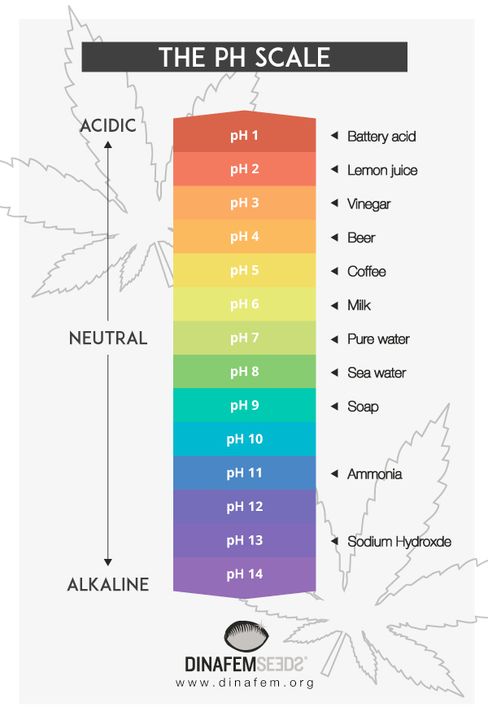- The pH (potential of hydrogen) of the nutrient solution is key in cannabis growing, as it plays a major role in the absorption and metabolism of nutrients, which directly affects the development and the health of plants.

What is pH and what is its role in gardening?
pH is a numerical way of defining the level of acidity or alkalinity of the nutrient solution and, more specifically, the concentration of positive hydrogen ions (H+).
pH is directly linked to nutrient absorption, thus playing a major role in plant nutrition and protection and directly affecting their well-being. The pH is responsible for the optimal distribution of nutrients and the prevention of deficiencies, giving rise to hardy, vigorous plants that are less likely to suffer from pests and diseases.
pH values range from 0 to 14, solutions with a pH less than 7 being acidic and solutions with a pH greater than 7 being alkaline. At pH 7 solutions are considered to be neutral. pH varies according to the substrate and is easier to monitor in soil (buffering capacity) than in hydroponics (a growing medium that is more unstable than soil and in which minerals interact in a much faster way).

If you water your plants with the wrong pH over several days, they will grow at a slower rate and suffer from nutrient deficiency, making pathogens and pests more likely to make their appearance. Under these conditions, the plants will also look weaker and duller, with discoloured leaves dry on the ends and yellowish, brownish spots scattered all over. These symptoms are easily detectable by daily visual inspection.
How to regulate pH in soil
Choosing the right soil – or preparing your own – is the first thing to consider. The substrate has to be homogeneous and contain the right elements for the pH to be neutral (of about 6.5). Remember that the substrate is one of the key elements for a successful crop.
pH is much more stable in organic substrates, as they contain a number of natural elements that regulate acidity and alkalinity, keeping them low and acting as a buffer that protects the root system. In order to avoid pH issues, thoroughly mix the soil until it is homogenous and stable.
If you grow in coco fibre, a neutral, inert substrate, you will have to pay special attention when preparing the nutrient solution. You will have to use pH regulators (+ to increase it and – to reduce it) and measure the pH whenever you water. You will also have to calibrate your digital pH meter frequently, at least every three days. Another option is using liquid pH test kits, a cheaper and more reliable method but also more time consuming than digital meters.
When preparing the nutrient solution, we recommend that you add all the nutrients to the water and then carry out the pH measurement.

Below you will find the standard recommended pH values for the growing and the flowering period in soil:

With certain organic fertilizers, it is possible to avoid pH fluctuations. That said, checking is always a good idea. If you use mineral fertilizers instead, you will have to be much more vigilant, as they often come in the form of chelates and have to be combined with certain organisms and micro-organisms that are found in the soil for nutrient absorption and metabolism to occur.
The good thing about using a substrate with buffering capacity such as soil, where nutrient assimilation occurs more slowly, is that if a mistake is made and it is identified timely, making adjustments is so much easier.
How to regulate pH in hydroponics
If you opt for hydroponics, it is essential that you master the technique, as the elements in the nutrient solution interact really quickly and thus the effects on the plants are almost immediate.
There are two key values in hydroponics that are directly interrelated – pH and EC (electroconductivity) – the former ensuring the absorption of the nutrients in the solution and the later indicating the concentrations in which they are found.
If these values are not well balanced, the negative effects will soon become apparent. This is why you will have to closely monitor them whenever you grow in hydroponics.

Below you will find the standard recommended pH values for the growing and the flowering period in hydroponics:

At the beginning of the growing period, young plants and cuttings should have a pH of 5.5, which should be gradually increased to 5.8, and then to 5.9 during stretch – vertical growth of the plant that lasts about 10-14 days according to the strain. Increase the pH to 6.0 on week 8 and to 6.2 on week 10, and keep it at 6.3-6.4 during the washing period (3 last weeks for efficient washing) and until harvest.
We recommend the use of enzymes once a week from the beginning of flowering to harvest in order to stop mineral salts from accumulating on the roots and from clogging the hydroponic system. A weekly dose following the manufacturer's instructions should be enough to avoid this problem.
What is the right pH for foliar spray?
The good thing about foliar spray is that the nutrients in the solution are rapidly absorbed through the leaves. If you opt for this method, you will have to adjust the pH before you water. With foliar spray, optimal nutrient absorption occurs at a pH of about 7 (neutral).
One important thing to remember is that you should supply the nutrients either as a foliar spray – only during the growing period – or via the roots, but never simultaneously – it is possible though to alternate both methods. Using foliar feed in soil allows you to quickly reduce or eliminate deficiencies in the growing period (of oxygen, for instance).

What pH meter to choose?
- Liquid pH test kits, which change the colour of the solution to indicate the pH level, are the cheapest and most reliable method of measuring the pH. The only but is that measurements take longer than with a digital meter.

- Very easy to use, digital meters are definitely the most popular measuring method with growers. You just have to immerse the meter into the solution to instantly get the pH value. The main downside here is that to ensure accurate results the meter has to be constantly calibrated, at least every three days.





Comments from our readers
Read comments in other languages:
Did you like this post?
Your opinion about our seeds is very important to us and can help other users a lot (your email address won't be made public).